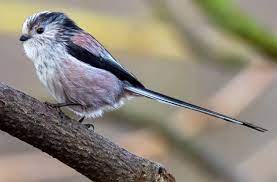The long-tailed tit, scientifically known as Aegithalos caudatus, is a small and charming bird that graces gardens and woodlands with its distinctive appearance and delightful antics. With its long tail, vibrant plumage, and social behaviors, the long-tailed tit stands out as a captivating member of the avian world. Join us as we explore 22 intriguing facts about these delightful birds, shedding light on their habits, adaptations, and endearing qualities.

1. Long-tailed Marvel: The long-tailed tit’s most distinguishing feature is its long, slender tail, which can be as long as its body.
2. Social Butterflies: Long-tailed tits are highly social birds that often travel in small, chatty flocks.
3. Family Bonds: These birds exhibit strong family ties, with multiple generations often remaining together in close-knit groups.
4. Nesting Wonders: Long-tailed tit nests are intricate, spherical creations woven from moss, spider silk, and feathers.
5. Cozy Accommodations: The nests are designed with an entrance at the top, providing warmth and protection from predators.
6. Colorful Attire: Long-tailed tits flaunt a delicate palette of pastel colors, including pinks, whites, and blacks.
7. Acrobatic Foraging: Their agile nature allows them to perform impressive acrobatics as they glean insects and spiders from leaves and branches.
8. Energetic Feeders: Long-tailed tits have high metabolic rates, requiring them to feed almost continuously to sustain their energy.
9. Nomadic Movements: These birds are known for their nomadic tendencies, moving in search of food and suitable habitats.
10. Fascinating Vocalizations: Long-tailed tits communicate through a range of calls, including trills, clicks, and melodious songs.
11. Cooperative Breeding: In some cases, non-breeding members of the flock assist in raising the young, contributing to their survival.
12. Insectivorous Diet: Long-tailed tits primarily feed on insects, larvae, and spiders, making them valuable pest controllers.
13. Distinctive Mating Display: During courtship, males showcase their nesting skills by offering materials to potential mates.
14. Northern Hemisphere Residents: Long-tailed tits inhabit temperate regions of Europe and Asia, favoring woodland and shrubby habitats.
15. Winter Survival: Their high-energy diet and roosting behavior help long-tailed tits endure harsh winter conditions.
16. Nest Parasitism: Occasionally, other birds, such as blue tits, may lay their eggs in long-tailed tit nests.
17. Varied Subspecies: Long-tailed tits have several subspecies with subtle differences in plumage and distribution.
18. Symbolism and Folklore: In some cultures, long-tailed tits symbolize happiness, loyalty, and familial unity.
19. Endearing Nicknames: The long-tailed tit has earned charming monikers like “flying lollipop” due to its round body and long tail.
20. Nesting Challenges: Harsh weather and predation pose risks to the success of long-tailed tit nests.
21. Citizen Science: Enthusiastic birdwatchers contribute valuable data on long-tailed tit populations through citizen science projects.
22. Conservation Concerns: Although they are not currently considered threatened, habitat loss and climate change could impact their future.
Conclusion
The long-tailed tit’s unique characteristics and social behaviors make it a beloved and intriguing species that continues to capture the hearts of bird enthusiasts worldwide.



















Add Comment